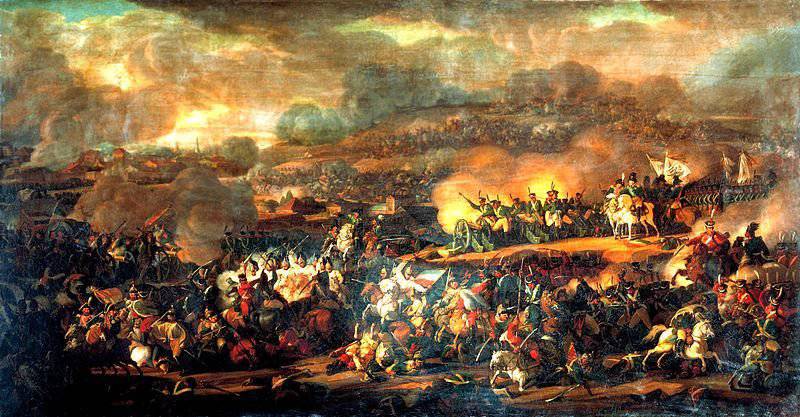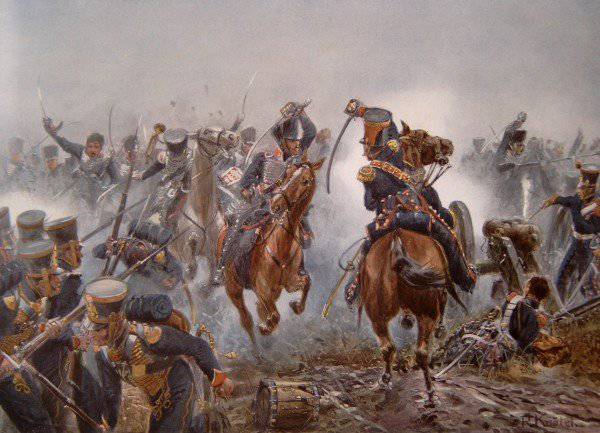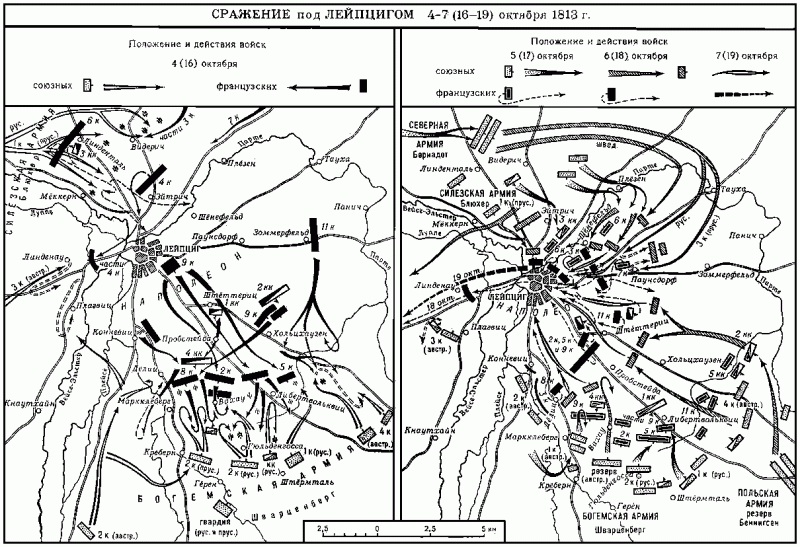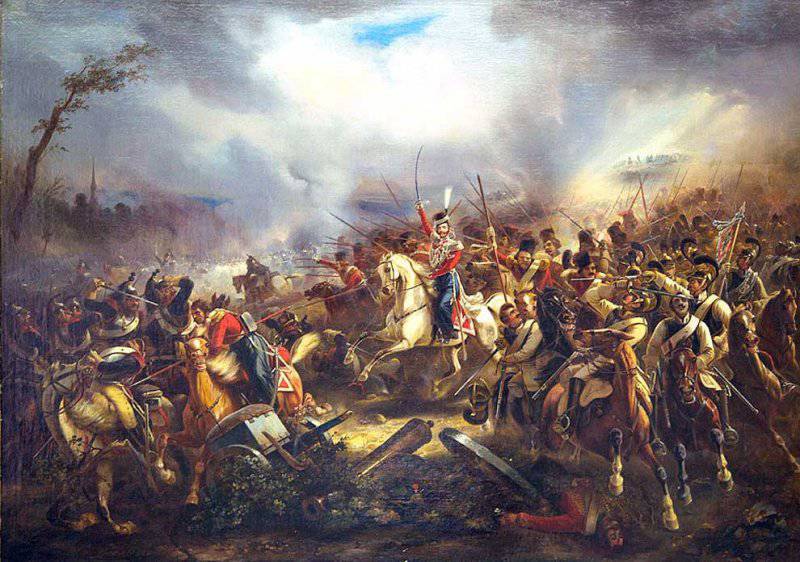Leipzig battle
prehistory
The military-strategic situation preceding the “Battle of the Nations” was favorable for the allies. France was exhausted by the continuous wars that lasted from the 1791 year, especially the Napoleon’s Empire suffered a great deal in the 1812 campaign of the year when almost the entire Great Army died or was captured in Russia. France had limited capacity to replenish the army with reinforcements, their quality plummeted (they had to drive older men, young men, there was no time to train them), failed to restore full-fledged cavalry killed in Russia, the industry could not cope with the task of replenishing the artillery fleet . And the allies of Napoleon, although they put up troops, but they were few in number and for the most part fought poorly (except for the Poles).
The sixth anti-French coalition, which included Russia, Prussia, Austria, England, Sweden, Spain, Portugal and a number of small German states, surpassed Napoleon’s empire in all parameters - the number of bayonets and sabers, tools, demographic resources, financial opportunities and economic potential. For the time being, Napoleon could restrain the enemy only at the expense of his commanding talent (in the ranks of his opponents, after Kutuzov's death, the commander, equal to the French emperor, did not appear), some indecision and poor interaction of the allied forces. Napoleon won several serious victories - the battles of Lutzen (2 in May), in Bautzen (21 of May) and Dresden (26 — 27 of August), but they did not lead to the collapse of the anti-French coalition, as he hoped, but only consolidated it. The losses of the Allied armies were easily replenished, the Allies even increased the number of their troops. In turn, the defeats of Napoleon’s marshals and generals weakened his army. 29 — 30 August defeated the corps of Vandam near Kulm in Bohemia, 6 of September Nei corps were defeated at Dennewitz in southwestern Prussia, and on September 28 on the banks of the Elbe at Vartenburg (Saxony) the corps of General Bertrand was defeated. France could not make up for these losses. The numerical advantage of the Allied armies was becoming increasingly tangible.
The Allied command, having received fresh reinforcements, decided to launch an offensive in early October in order to surround and destroy the French army. Napoleon at this time held a defense around Dresden in the east of Saxony. Under the command of Field Marshal Gebhard Blucher, the Silesian army overtook Dresden from the north and forced the Elbe River north of Leipzig. The Northern Army, under the leadership of the Swedish crown prince Jean Bernadot, also joined up with it. The Bohemian army, commanded by Field Marshal Karl Schwarzenberg, drove Murat's troops, bypassed Dresden from the south and also headed towards Leipzig, to the rear of Napoleon's army. Prussian troops marched north from Wartenburg, Swedish troops also from the north, but in the second echelon after the Prussians, Russians and Austrians from the south and west.
The French emperor left a strong garrison in Dresden and also moved to Leipzig, planning to crush the enemy troops piece by piece — first defeating Blucher and Bernadot, and then Schwarzenberg. Napoleon himself wanted a decisive battle, hoping to win the campaign with one blow. However, he overestimated his forces, exhausted by previous battles and marches, underestimated the strength of the allied forces and did not have complete data on the disposition of the enemy forces. Napoleon Bonaparte mistakenly believed that the Russian-Prussian Silesian army was located far to the north, further from Leipzig, and he doubted the rapid arrival of the Bohemian army.
Forces of the parties. Disposition
By the beginning of the battle, the Bohemian Austro-Russian-Prussian Army — 133 thousand people, 578 guns and the Silesian Russian-Prussian Army — 60 thousand soldiers, 315 guns, reached Leipzig. Thus, at the beginning of the battle, the Allied forces numbered about 200 thousand people. Already in the battle tightened Northern Prussian-Russian-Swedish army - 58 thousand people, 256 guns, Polish Russian army under the command of General Leonty Benningsen -. 46 thousand soldiers, 162 guns and 1-th Austrian corps under the command of Jerome Colloredo-Mansfeld. - 8 thousand people, 24 guns. By the beginning of the battle, the northern army of Bernadot was located in Halle (in 30 km north of Leipzig), and the Polish army of Bennigsen in Waldheim (in 40 km east of Leipzig). During the battle, the strength of the Allied army increased to 310 thousand people (according to other sources, to 350 thousand) with almost 1400 guns. As part of the allied army, there were 127 thousand Russians, 89 thousand Austrian nationals - Austrians, Hungarians, Slavs, 72 thousand Prussians, 18 thousand Swedes, etc. Austrian Field Marshal Prince Karl Schwarzenberg was the Allied Commander. However, his power was limited to monarchs, as the Russian Emperor Alexander I constantly intervened in the operational management. In addition, the commanders of individual armies and even corps had greater autonomy in decision-making. In particular, in the Northern Army, Prussian commanders submitted to Bernadotte only formally.
Napoleon's army numbered about 200 thousand soldiers (according to other sources, about 150 thousand people) and 700 guns. Leipzig the French had 9 infantry corps - more than 120 thousand soldiers, Guard -. 3 infantry corps, a cavalry corps and the artillery reserve, up to 42 thousand fighters, 5 cavalry corps -. 24 thousand people, plus a garrison Leipzig -. About 4 thousand . person. Most of the army were French, but there were many different kinds of Germans, Poles, Italians, Belgians, Dutch.
3 (15) October Napoleon deployed his troops around Leipzig. The main part of the army covered the city from the south along the River Pleisse, from Konnewitz to the village of Markkleyberg, then further east through the villages of Wachau, Libertovolkwitz and to Holzhausen. The road from the western direction was covered by the corps of General Bertrand (12 thousand people), which was located at Lindenau. From the north, Leipzig was defended by the troops of Marshals Marmont and Ney - 2 infantry and 1 cavalry corps (up to 50 thousand soldiers). Napoleon, realizing the numerical superiority of the enemy forces, wanted to strike 4 (16) in October against the Bohemian army, and, before approaching the rest of the enemy’s forces, defeat it or at least seriously weaken it. For the offensive, an assault grouping of 5 infantry, 4 cavalry corps and 6 guard divisions was created, about 110-120 thousand soldiers in total. It was headed by Marshal Joachim Murat.
The allied command, under the pressure of the three monarchs Alexander I, Friedrich Wilhelm III and Franz I, also planned to conduct attacking actions, fearing that Napoleon, using his central position, could separately break the Northern army, holding back the Bohemian army with a strong barrier. In addition, there was a desire to break up the enemy troops in parts, preventing the concentration of enemy forces. Schwarzenberg decided in the morning to strike from the southern direction with the forces of the Bohemian army. Initially, the Austrian field marshal suggested that the main army forces should be thrown into Konnewitz, piercing the enemy defenses in the marshy lowland of the Plais and Weisse-Elster rivers, bypassing the enemy’s right flank and taking the shortest western road to Leipzig. However, the Russian emperor Alexander Pavlovich criticized the plan, pointing to the complexity of the area.
The Bohemian army was divided into three groups and reserves. The first (main) group, under the general command of the General of Infantry Barclay de Tolly, included the 4 Austrian Corps of Klenau, the Russian troops of General Wittgenstein, and the Prussian Corps of Field Marshal Kleist, total 84 thousand, 404 guns. The grouping of Barclay was to hit the French army on the front Kreburn - Wachau - Liebertvolkwitz, in effect attacking the enemy head-on, from the southeast. The second group was commanded by Austrian General Maximilian von Merfeld. It consisted of the 2 Austrian Corps and Austrian reserves, all in all 30-35 thousand people with 114 guns. He was to advance between the rivers of the Place and the Weisse-Elster, seize the crossings and strike the right flank of the French army. The third detachment under the command of Ignats Gyulai (Giulai) was to attack from the west, on Lindenau, and seize the crossing through Weiss-Elster west of Leipzig. The group was supposed to block the escape route to the west. The basis of the detachment of Gyulai was the 3 Austrian Corps - about 20 thousand people. The Russian-Prussian Guard made up a reserve. Bluchera’s Silesian army was to launch an offensive from the north on the Mekkerk-Videritz front.
Battle
The course of the battle 4 (16) October. The day was overcast. Before dawn, Russian-Prussian troops began their advance and opened artillery fire around 8 in the morning. The advance units began to approach the enemy. The battle was reduced to a series of stubborn battles for Markkleberg, the Wachau, the Libertroverkwitz, as well as the crossing at Konnevitz. Russian-Prussian troops under the general command of Kleist - 14-division of General Helfreichai, 12-I Prussian brigade and 4 battalion of the 9-brigade, near 9.30 captured the village Markkleberg. Here the French-Polish forces under the command of the marshals of Augereau and Poniatowski kept the defense. Four times Napoleon's troops fought off the village and four times the Russians and the Prussians again took Markkleberg by storm.
The Wachau village was also captured by Russian-Prussian troops under the command of Duke Yevgeny of Württemberg — the 2 Infantry Corps, the Russian cavalry of General Palen — the hussars, lancers and Cossacks, and the 9-I Prussian Brigade. However, due to the strong fire of the French artillery, the village was left by noon. Liebertvolkvits stormed the Russian-Prussian troops under the general command of Lieutenant-General A.I. Gorchakova - 5-I Russian division of General Mezentsev, 10-I Prussian Brigade of Major-General Pirch and 11-I Prussian Brigade of Lieutenant-General Tsiten, as well as 4-nd Austrian Corps of General Mapan. The defense kept the corps of General Loriston and Marshal Macdonald. After a fierce battle, when I had to fight for every street and house, the village was captured. Both sides suffered heavy losses. But after the French received reinforcements - the 36 Division, the Allied forces were forced to withdraw. The offensive of 2 of the Austrian corps did not bring success, and in the afternoon, when the French counteroffensive began, Commander-in-Chief Schwarzenberg sent Austrian troops to help General Barclay de Tolly. The blow of 3 of the Austrian corps Gyulai on Lidenau also did not bring success.
The Bohemian army exhausted its forces and lost its offensive outburst. Her strength now only enough for defense. In this situation, the French emperor decided to strike at the center of the enemy positions in the general direction of the Wachau - Guldengossa. At 15 hours, the French cavalry under Murat (about 10 thousand horsemen), with the support of a strong artillery group - 160 guns of General A. Drouot, dealt a powerful blow. French cuirassiers and dragoons, with the support of infantry and artillery, broke through the Russian-French line. The Allied monarchs and Schwarzenberg were threatened, the enemy's cavalry broke through to the hill, where they watched the battle. The French were already a few hundred meters away, chasing the runners. They were saved by a counterattack of the Life Guard Cossack regiment under the command of Ivan Efremov. Cossacks and a company of Russian artillery restrained the onslaught of the enemy until reinforcements arrived. Against the French cavalry, the cavalry detachment of Palen, the Grenadier Division from the Raevsky corps and the Prussian brigade from the Kleist corps were abandoned. The reinforcements finally stopped the enemy and closed the gap in the front.
Hood Behlin. Attack of the Cossack Life Guard at Leipzig.
Napoleon, determined to win at any cost before the approach of the new armies of the enemy, gave the order to attack the weakened center of the Bohemian army with foot and horse guards. However, the strike of the Austrian troops on the right flank of the French troops changed his plans. The emperor was forced to send part of the guard to help the troops Poniatowski. After a stubborn battle, Austrian troops were driven back, and Merfeld himself was captured by the French.

Battle on Vakhautsky heights. V.I. Moshkov (1815).
Blücher’s Silesian Army delivered a strike in the Videritz and Mökkern areas. Blucher did not wait for the approach of the northern army of Bernadotte and went on the offensive. The village of Videritz was defended by Polish General Dombrovsky, who held back the onslaught of Russian troops by General Lanzheron all day. The Marmona Corps defended positions in the village of Mykern. Marmont was ordered to move south to the Wachau to take part in the battle. However, having received news of the approaching forces of the enemy, he stopped and sent a request for help to Marshal Ney. The Prussian corps of York, after numerous attacks, took the village, suffering heavy losses. Marmont's corps was crushed. Thus, the Silesian army broke through the French defense in the north of Leipzig, and the forces of Marmont and Nei could not take part in the key battle of the Wachau.
At nightfall, the battle ended. Most of the battlefield was left to the French army. The French pushed the Allied forces back from the Wachau to Güldengossa and from the Libertyachkwitz to the University Forest, but could not break through the front and achieve a decisive victory. In general, the first day of the battle did not meet the expectations of either the French or the allies, although both sides suffered huge losses - up to 60-70 thousand people. The places of the most stubborn fights were simply overwhelmed with corpses. Prussian soldiers from the army of Blucher made obstructions of corpses, determined to hold their positions. On the night of October 5 (17), fresh Northern and Polish armies approached. Now the allied army had a serious superiority over the enemy.

Brandenburg Hussars near Möckern, Leipzig, October 16 1813. Artist Richard Knotel.
Action 5 (17) October. The French emperor was aware of the danger, but did not leave the position at Leipzig. He hoped to conclude a truce and begin peace negotiations. Napoleon, through Austrian General Merfeld, sent a letter to all the Allied monarchs with a proposal to cease fire and start peace talks. Napoleon was ready for decisive concessions. He agreed to give up the already lost Warsaw duchy, as well as Holland and Hanseatic cities, was ready to restore the independence of Italy, and even abandon the Union of Rhine and Spain. Napoleon made the only demand - England had to return the captured French colonies.
However, the Allied monarchs did not respond. Apparently, the proposal of Napoleon considered the recognition of weakness. In general, the day passed quietly, both sides were looking for the wounded, they were burying the dead. Only in the northern direction, the troops of Blucher continued the offensive and, seizing the villages of Eitrich (Oitritsh) and Golis, came close to Leipzig itself. At 2 in the afternoon, a military meeting was held in the village of Zestewitz. Commander-in-Chief Schwarzenberg suggested resuming the battle immediately. But Bennigsen said that his army was tired of a long march, she needed rest. It was decided to resume the offensive the next morning. The army of Bennigsen was to attack on the right flank, together with the Austrian 4 corps.
Napoleon, realizing that the previous positions could not be held, and on the night of October 6 (18) regrouped. The old positions, which were unreasonable to defend because of a lack of strength, left. Troops retreated about 1 an hour from the city. By morning, the French troops took up positions on the Lindenau - Konnevitz - Holzhausen - Schonefeld line. New positions defended to 150 thousand soldiers with 630 guns.
To be continued ...


Information